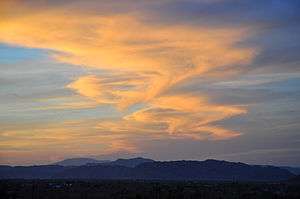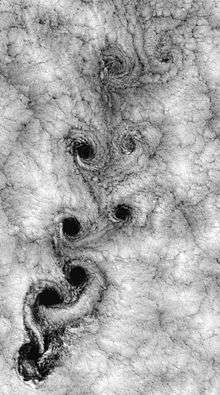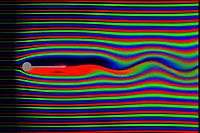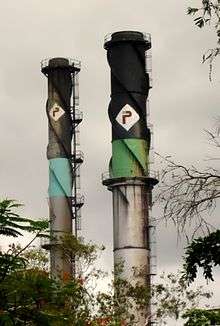Kármán vortex street
In fluid dynamics, a Kármán vortex street (or a von Kármán vortex sheet) is a repeating pattern of swirling vortices caused by the unsteady separation of flow of a fluid around blunt bodies. It is named after the engineer and fluid dynamicist Theodore von Kármán,[1] and is responsible for such phenomena as the "singing" of suspended telephone or power lines, and the vibration of a car antenna at certain speeds.
Analysis


A vortex street will only form at a certain range of flow velocities, specified by a range of Reynolds numbers (Re), typically above a limiting Re value of about 90. The (global) Reynolds number for a flow is a measure of the ratio of inertial to viscous forces in the flow of a fluid around a body or in a channel, and may be defined as a nondimensional parameter of the global speed of the whole fluid flow:
where:
- = the free stream flow speed (i.e. the flow speed far for the fluid boundaries like the body speed relative to the fluid at rest, or an inviscid flow speed, computed through the Bernoulli equation), which is the original global flow parameter, i.e. the target to be nondimansionalised.
- = a characteristic length parameter of the body or channel
- = the free stream kinematic viscosity parameter of the fluid, which in turn is the ratio:
between:
- = the reference fluid density.
- = the free stream fluid dynamic viscosity
For common flows (the ones which can usually be considered as incompressible ar isothermal), the kinematic viscosity is everywhere uniform over all the flow field and constant in time, so thereis no choice on the viscosity parameter, which becomes naturally the kinematic viscosity of the fluid being considered at the temperature being considered. On the other hand, the reference length is always an arbitrary parameter, so particular attention should be put when comparing flows around different obstacles or in channels of different shapes: the global Reynolds numbers should be referred to the same reference length. This is actually the reason for which most precise sources for airfoil and channel flow data specify the reference length at a pedix to the Reynolds number. The reference length can vary depending on the analysis to be performed: for body with circle sections such as circular cyliners or spheres, one usually chooses the diameter; for an airfoil, a generic noncircular cylinder or a bluff body or a revolution body like a fuselage or a submarine, it is usually the profile chord or the profile thickness, or some other given widths that are in fact stable design inputs; for flow channels usually the hydraulic diameter) about which the fluid is flowing.
Interestingly, for an aerodynamic profile the reference length depends on the analysis. In fact, the profile chord is usually chosen as the reference length also for aerodynamic coefficient for wing sections and thin profiles in which the primary target is to maximize the lift coefficient or the lift/drag ratio (i.e. as usual in thin airfoil theory, one would employ the chord Reynolds as the flow speed parameter for comparing different profiles). On the other hand, for fairings and struts the given parameter is usually the dimension of internal structure to be streamlined (let us think for simplicity it is a beam with circular section), and the main target is to minimize the drag coefficient or the drag/lift ratio. The main design parameter which becomes naturally also a reference length is therefore the profile thickness (the profile dimension or area perpendicular to the flow direction), rather than the profile chord.
The range of Re values will vary with the size and shape of the body from which the eddies are being shed, as well as with the kinematic viscosity of the fluid. Over a large Red range (47<Red<105 for circular cylinders; reference lenght is d: diameter of the circular cylinder) eddies are shed continuously from each side of the circle boundary, forming rows of vortices in its wake. The alternation leads to the core of a vortex in one row being opposite the point midway between two vortex cores in the other row, giving rise to the distinctive pattern shown in the picture. Ultimately, the energy of the vortices is consumed by viscosity as they move further down stream, and the regular pattern disappears.
When a single vortex is shed, an asymmetrical flow pattern forms around the body and changes the pressure distribution. This means that the alternate shedding of vortices can create periodic lateral (sideways) forces on the body in question, causing it to vibrate. If the vortex shedding frequency is similar to the natural frequency of a body or structure, it causes resonance. It is this forced vibration that, at the correct frequency, causes suspended telephone or power lines to "sing" and the antenna on a car to vibrate more strongly at certain speeds.
In meteorology

The flow of atmospheric air over obstacles such as islands or isolated mountains sometimes gives birth to von Kármán vortex streets. When a cloud layer is present at the relevant altitude, the streets become visible. Such cloud layer vortex streets have been photographed from satellites.[2]
Engineering problems



In low turbulence, tall buildings can produce a Kármán street so long as the structure is uniform along its height. In urban areas where there are many other tall structures nearby, the turbulence produced by these prevents the formation of coherent vortices.[3] Periodic crosswind forces set up by vortices along object's sides can be highly undesirable, and hence it is important for engineers to account for the possible effects of vortex shedding when designing a wide range of structures, from submarine periscopes to industrial chimneys and skyscrapers.
In order to prevent the unwanted vibration of such cylindrical bodies, a longitudinal fin can be fitted on the downstream side, which, provided it is longer than the diameter of the cylinder, will prevent the eddies from interacting, and consequently they remain attached. Obviously, for a tall building or mast, the relative wind could come from any direction. For this reason, helical projections that look like large screw threads are sometimes placed at the top, which effectively create asymmetric three-dimensional flow, thereby discouraging the alternate shedding of vortices; this is also found in some car antennas. Another countermeasure with tall buildings is using variation in the diameter with height, such as tapering - that prevents the entire building being driven at the same frequency.
Even more serious instability can be created in concrete cooling towers, for example, especially when built together in clusters. Vortex shedding caused the collapse of three towers at Ferrybridge Power Station C in 1965 during high winds.
The failure of the original Tacoma Narrows Bridge was originally attributed to excessive vibration due to vortex shedding, but was actually caused by aeroelastic flutter.
Kármán turbulence is also a problem for airplanes, especially at landing.[4][5]
Formula
This formula will generally hold true for the range 250 < Red < 2 × 105:
where:
- f = vortex shedding frequency.
- d = diameter of the cylinder
- U = flow velocity.
This dimensionless parameter St is known as the Strouhal number and is named after the Czech physicist, Vincenc Strouhal (1850–1922) who first investigated the steady humming or singing of telegraph wires in 1878.
History
Although named after Theodore von Kármán,[6][7] he acknowledged[8] that the vortex street had been studied earlier by Mallock[9] and Bénard.[10]
See also
References
- ↑ Theodore von Kármán, Aerodynamics. McGraw-Hill (1963): ISBN 978-0-07-067602-2. Dover (1994): ISBN 978-0-486-43485-8.
- ↑ "Rapid Response - LANCE - Terra/MODIS 2010/226 14:55 UTC". Rapidfire.sci.gsfc.nasa.gov. Retrieved 2013-12-20.
- ↑ Irwin, Peter A. (September 2010). "Vortices and tall buildings: A recipe for resonance". Physics Today. American Institute of Physics. 63 (9): 68–69. Bibcode:2010PhT....63i..68I. doi:10.1063/1.3490510. ISSN 0031-9228.
- ↑ Wake turbulence
- ↑ AIRPORT OPENING CEREMONY POSTPONED
- ↑ T. von Kármán: Nachr. Ges. Wissenschaft. Göttingen Math. Phys. Klasse pp. 509–517 (1911) and pp. 547–556 (1912).
- ↑ T. von Kármán: and H. Rubach, 1912: Phys. Z.", vol. 13, pp. 49–59.
- ↑ T. Kármán, 1954. Aerodynamics: Selected Topics in the Light of Their Historical Development (Cornell University Press, Ithaca), pp. 68–69.
- ↑ A. Mallock, 1907: On the resistance of air. Proc. Royal Soc., A79, pp. 262–265.
- ↑ H. Bénard, 1908: Comptes rendus de l'Académie des Sciences (Paris), vol. 147, pp. 839–842, 970–972.
External links
| Wikimedia Commons has media related to Von Kármán vortex streets. |
- Encyclopedia of Mathematics article on von Karman vortex shedding
- Kármán vortex street formula calculator
- 3D animation of the Vortex Flow Measuring Principle
- Vortex streets and Strouhal instability
- How Insects Fly (which can produce von Kármán vortices)
- YouTube — Flow visualisation of the vortex shedding mechanism on circular cylinder using hydrogen bubbles illuminated by a laser sheet in a water channel
- Various Views of von Karman Vortices, NASA page
.jpg)